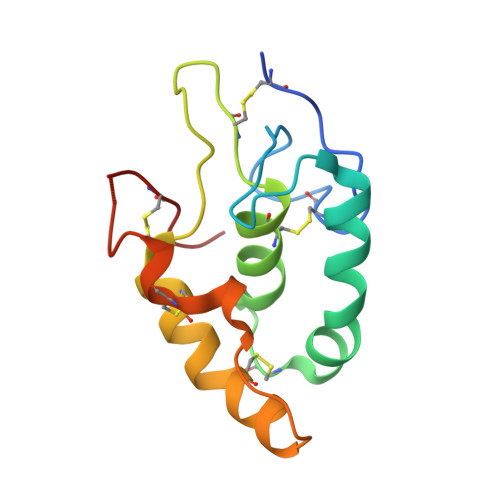Wnt5a promotes Frizzled-4 signalosome assembly by stabilizing cysteine-rich domain dimerization.
DeBruine, Z.J., Ke, J., Harikumar, K.G., Gu, X., Borowsky, P., Williams, B.O., Xu, W., Miller, L.J., Xu, H.E., Melcher, K.(2017) Genes Dev 31: 916-926
- PubMed: 28546512
- DOI: https://doi.org/10.1101/gad.298331.117
- Primary Citation of Related Structures:
5UWG - PubMed Abstract:
Wnt/β-catenin signaling is activated when extracellular Wnt ligands bind Frizzled (FZD) receptors at the cell membrane. Wnts bind FZD cysteine-rich domains (CRDs) with high affinity through a palmitoylated N-terminal "thumb" and a disulfide-stabilized C-terminal "index finger," yet how these binding events trigger receptor activation and intracellular signaling remains unclear. Here we report the crystal structure of the Frizzled-4 (FZD 4 ) CRD in complex with palmitoleic acid, which reveals a CRD tetramer consisting of two cross-braced CRD dimers. Each dimer is stabilized by interactions of one hydrophobic palmitoleic acid tail with two CRD palmitoleoyl-binding grooves oriented end to end, suggesting that the Wnt palmitoleoyl group stimulates CRD-CRD interaction. Using bioluminescence resonance energy transfer (BRET) in live cells, we show that WNT5A stimulates dimerization of membrane-anchored FZD 4 CRDs and oligomerization of full-length FZD 4 , which requires the integrity of CRD palmitoleoyl-binding residues. These results suggest that FZD receptors may form signalosomes in response to Wnt binding through the CRDs and that the Wnt palmitoleoyl group is important in promoting these interactions. These results complement our understanding of lipoprotein receptor-related proteins 5 and 6 (LRP5/6), Dishevelled, and Axin signalosome assembly and provide a more complete model for Wnt signalosome assembly both intracellularly and at the membrane.
Organizational Affiliation:
Center for Cancer and Cell Biology, Laboratory for Structural Biology and Biochemistry, Van Andel Research Institute, Grand Rapids, Michigan 49503, USA.
















